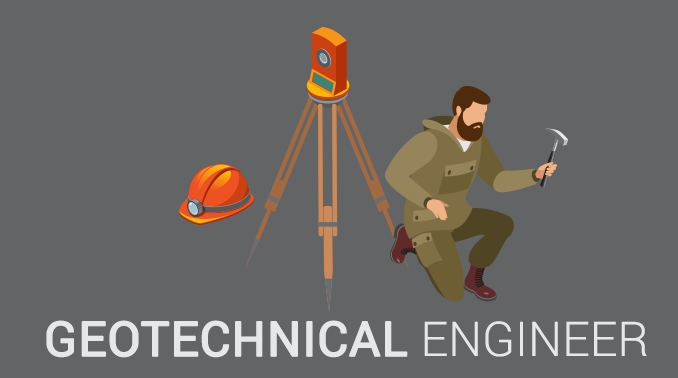Geotheta - Questions
Geotheta - Questions
Blog Article
The 25-Second Trick For Geotheta
Table of ContentsGeotheta Things To Know Before You BuyRumored Buzz on GeothetaRumored Buzz on GeothetaGeotheta Can Be Fun For EveryoneThe Ultimate Guide To Geotheta

They conduct site examinations, collect samples, execute laboratory examinations, and assess information to review the suitability of the ground for building tasks - Consulting Engineers. Based on their searchings for, geotechnical engineers provide recommendations for foundation style, incline security, preserving structures, and mitigation of geotechnical hazards. They collaborate with various other professionals, such as designers, structural designers, and building teams, to make sure that geotechnical considerations are integrated right into the general project layout and implementation
By analyzing the actions and residential properties of soil and rock, they can recognize potential geotechnical dangers such as landslides, dirt settlement, or slope instability. Their knowledge aids protect against failures or crashes that could jeopardize lives and property. Below are some thorough duties and responsibilities of a geotechnical designer: Site Investigation: Geotechnical designers conduct website examinations to gather information on subsurface conditions.
They interpret the data to understand the buildings and habits of the soil and rock, including their strength, permeability, compaction characteristics, and groundwater problems. Geotechnical Analysis and Design: Geotechnical designers assess the information accumulated throughout site examinations to evaluate the security and suitability of the website for building and construction tasks. They carry out geotechnical calculations and modeling to assess elements such as bearing ability, negotiation, slope stability, lateral planet pressures, and groundwater circulation.
Getting My Geotheta To Work
Structure Style: Geotechnical engineers play an essential duty in creating foundations that can safely sustain the desired framework. They examine the dirt problems and lots demands to determine the ideal foundation type, such as shallow foundations (e.g., footings), deep foundations (e.g (https://geotheta.carrd.co/)., piles), or specialized strategies like soil enhancement. They take into consideration factors such as settlement limits, birthing capability, and soil-structure interaction to develop optimum foundation designs
They evaluate building and construction strategies, screen website tasks, and carry out field examinations to verify that the design referrals are followed. If unforeseen geotechnical problems occur, they examine the situation and give suggestions for remediation or adjustments to the layout. Risk Analysis and Mitigation: Geotechnical engineers examine geotechnical risks and risks linked with the job website, such as landslides, liquefaction, or dirt disintegration.

Collaboration and Communication: Geotechnical designers function closely with various other experts included in a job, such as engineers, architectural designers, and building teams. Efficient communication and cooperation are necessary to integrate geotechnical considerations right into the general project design and building process. Geotechnical designers offer technological expertise, response queries, and make sure that geotechnical needs are met.
The 6-Second Trick For Geotheta
Here are some kinds of geotechnical designers: Foundation Engineer: Structure designers focus on designing and assessing foundations for frameworks. They analyze the dirt problems, tons needs, and site characteristics to establish the most ideal structure kind and design, such as shallow foundations, deep foundations, or specialized methods like stack structures.
They review the aspects affecting slope security, such as dirt residential or commercial properties, groundwater problems, and slope geometry, and create methods to stop slope failings and minimize dangers. Quake Designer: Quake engineers specialize in assessing and designing structures to withstand seismic forces. They examine the seismic risk of a site, evaluate soil liquefaction possibility, and establish seismic layout standards to guarantee the security and durability of structures throughout quakes.
They carry out area testing, gather samples, and analyze the collected information to identify the soil buildings, geologic formations, and groundwater problems at a website. Geotechnical Instrumentation Engineer: Geotechnical instrumentation designers focus on tracking and gauging the actions of dirt, rock, and structures. They mount and preserve instrumentation systems that check elements such as soil negotiation, groundwater levels, incline movements, and architectural variations to examine efficiency and supply very early warnings of possible problems.
The 2-Minute Rule for Geotheta
They perform tests such as triaxial tests, debt consolidation examinations, direct shear tests, and leaks in the structure examinations to gather information for geotechnical evaluation and style. Geosynthetics Designer: Geosynthetics designers specialize in the layout and application of geosynthetic products, such as geotextiles, geogrids, and Visit Your URL geomembranes. They utilize these materials to improve soil stability, strengthen slopes, offer drain options, and control disintegration.
They often tend to be investigative individuals, which means they're intellectual, reflective, and analytical. They are curious, methodical, rational, logical, and logical. Some of them are additionally social, indicating they're kind, generous, participating, person, caring, helpful, understanding, tactful, and pleasant - Tailings Engineer.
In the workplace environment, geotechnical designers use specialized software tools to do calculations, develop layouts, and evaluate data. They prepare records, testimonial project specifications, interact with clients and team members, and coordinate project tasks. The workplace setting offers a helpful environment for study, analysis, and cooperation with various other professionals involved in the project.
Some Known Incorrect Statements About Geotheta
They regularly check out job sites to perform site investigations, analyze geotechnical conditions, and collect information for analysis. These sees involve taking a trip to various areas, sometimes in remote or difficult terrains. Geotechnical engineers may execute soil sampling, conduct tests, and display building activities to make sure that the geotechnical aspects of the task are being applied appropriately.
Geotechnical designers additionally function in specialized geotechnical labs. Geotechnical lab designers work thoroughly in these atmospheres, taking care of screening devices, running tools, and tape-recording data.
Report this page